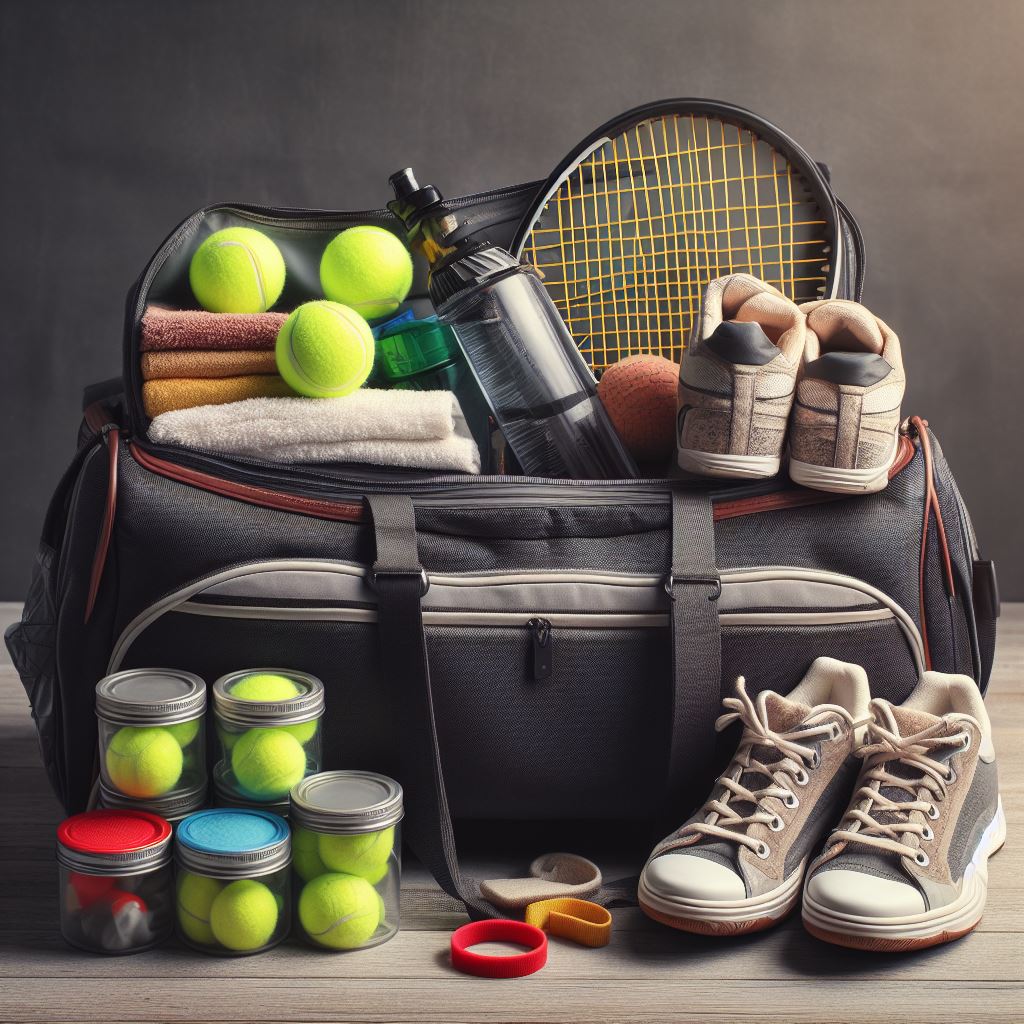Are you looking to introduce your child to the exciting world of tennis? Look no further!
In our article, ‘Tennis Basics for Kids: Fun Mastery,’ we will guide you through the essential steps to help your child develop a strong foundation in the sport.
From understanding the equipment and court basics to mastering the forehand and backhand strokes, we have everything you need to engage your child in an informative and interactive way.
Let’s dive in and unlock their tennis potential together!
Key Takeaways
- Choose an appropriate size and weight racket for the child.
- Progress from smaller to larger courts as skills improve.
- Learn and practice different grips for forehand and backhand strokes.
- Focus on hand-eye coordination and footwork through various drills and games.
Getting Started: Equipment and Court Basics
To get started with tennis, kids will need the right equipment and an understanding of the basic layout of a tennis court. Choosing the right racket is crucial for young players. It’s important to find a racket that is the appropriate size and weight for their age and strength. A racket that is too heavy or too large can hinder their ability to swing and control the ball effectively. Many sporting goods stores offer junior rackets specifically designed for kids, making it easier to find the perfect fit.
Equally important is understanding the proper court size. Tennis courts are divided into different sizes depending on the age and skill level of the players. For young beginners, it is recommended to start with a smaller court. This allows them to cover the distance more easily and develop their skills in a controlled environment. As they progress, they can move on to larger courts.
By having the right equipment and understanding the basic layout of a tennis court, kids are equipped with the tools they need to begin their tennis journey.
Now, let’s move on to the next step: mastering the forehand and backhand strokes.
Mastering the Forehand and Backhand Strokes
To achieve mastery in tennis, kids must develop their skills in executing the forehand and backhand strokes with precision and control. These fundamental shots form the basis of a player’s game and are essential for success on the court.
Here are five key aspects that young tennis players should focus on when mastering their forehand and backhand strokes:
- Grip techniques: Understanding the different ways to hold the racket is crucial for generating power and control in each shot. Kids should learn the Eastern grip for their forehand and the Continental grip for their backhand to maximize their potential.
- Shot placement: Improving accuracy and control with forehand and backhand shots is vital. Kids should practice hitting the ball at different targets on the court, such as the corners or down the line, to develop their ability to place shots effectively.
- Footwork: Proper footwork is essential for getting into the right position to hit the ball. Kids should focus on maintaining a balanced stance and moving quickly and efficiently to set up for each shot.
- Swing technique: Developing a smooth and fluid swing motion is crucial for generating power and accuracy. Kids should practice proper swing technique, emphasizing a full follow-through and using their whole body to generate power.
- Consistency: Consistency is key in tennis. Kids should aim to hit the ball cleanly and consistently, focusing on making solid contact with the center of the racket face.
By mastering these aspects of the forehand and backhand strokes, young tennis players can lay a solid foundation for their game.
Understanding the rules of the game is the next step in their tennis journey.
Understanding the Rules of the Game
Now that young tennis players have mastered the forehand and backhand strokes, it is important for them to understand the rules of the game in order to fully participate and compete on the court. Tennis has a unique scoring system that may seem confusing at first, but with a little explanation, it becomes clear and easy to follow.
In tennis, each match is divided into sets, and each set is made up of games. To win a set, a player must win six games. However, if both players are tied at 5-5, a player must win the next two games to secure the set. In addition, if the set reaches 6-6, a tiebreak game is played to determine the winner of the set.
Within each game, scoring is a bit different. The first point is called ’15,’ the second point is ’30,’ and the third point is ’40.’ If both players have won three points, it is known as ‘deuce.’ From deuce, a player must win two consecutive points to win the game.
During a match, an umpire is responsible for enforcing the rules and making sure the game is played fairly. They also call the score and make decisions on close line calls. It is important for young players to understand the role of the umpire and respect their decisions.
Understanding the rules of tennis is essential for young players to fully enjoy the sport and compete with confidence. By grasping the scoring system and the role of the umpire, young tennis players will be well-equipped to face any opponent on the court.
Developing Hand-Eye Coordination and Footwork
One crucial aspect of tennis skill development for kids is mastering hand-eye coordination and footwork. These two fundamental skills are essential for success on the tennis court. By improving hand-eye coordination, children can better track the ball and make precise contact, while developing strong footwork helps them move efficiently and quickly around the court.
Here are some drills and exercises that can help kids improve their hand-eye coordination and footwork in tennis:
- Balloon Bounce: Have the child bounce a balloon on their racket, trying to keep it in the air for as long as possible. This drill helps improve hand-eye coordination and racket control.
- Cone Shuffle: Set up a series of cones in a straight line, and have the child shuffle from side to side, touching each cone with their foot. This drill improves lateral movement and agility.
- Mini Tennis: Play a game of mini tennis with the child, using a smaller court and a lower net. This game encourages quick footwork and improves hand-eye coordination.
- Shadow Drills: Have the child mimic the movements of a professional tennis player by shadowing their strokes and footwork. This exercise helps develop muscle memory and coordination.
- Speed ladder: Set up a speed ladder on the court and have the child practice quick footwork by moving through the ladder as fast as possible. This drill improves foot speed and agility.
Fun Drills and Games to Enhance Skills
How can fun drills and games be used to enhance tennis skills for kids?
Fun drills and games can be a great way to engage kids in tennis and help them develop their skills in a fun and interactive manner. By incorporating competitive challenges and team building activities into these drills and games, children can not only improve their tennis abilities but also learn important life skills such as teamwork, communication, and sportsmanship.
Competitive challenges can be introduced through various drills that focus on specific tennis skills. For example, a drill that involves hitting targets with the tennis ball can be turned into a competition where kids earn points for each successful hit. This not only encourages them to improve their accuracy but also adds an element of excitement and friendly competition.
Team building activities can also be incorporated into tennis drills and games. For instance, a doubles match can be organized where kids are paired up and encouraged to work together to win the match. This promotes teamwork, communication, and cooperation, as they need to strategize and support each other on the court.
Incorporating fun drills and games into tennis training sessions helps to keep kids engaged and motivated, making the learning process enjoyable and effective. By providing opportunities for competitive challenges and team building activities, children not only enhance their tennis skills but also develop important life skills that will benefit them both on and off the court.
Frequently Asked Questions
What Should Kids Wear When Playing Tennis?
When playing tennis, kids should wear appropriate tennis clothing and suitable footwear. Tennis clothing for kids typically includes comfortable and breathable shirts, shorts or skirts, and socks. Suitable footwear should provide good traction and support for quick movements on the court.
How Do You Properly Grip a Tennis Racket?
Proper grip technique is crucial for a successful tennis game. There are different grip styles, such as the continental grip and the eastern grip, each offering advantages for specific shots. Mastering the correct grip enhances control and power.
Are There Any Safety Precautions Kids Should Take While Playing Tennis?
When it comes to playing tennis, it is important for kids to follow proper tennis court etiquette and take safety precautions. Warming up before playing can also help prevent injuries and enhance performance.
How Often Should Kids Practice Their Tennis Skills?
Regular practice is essential for kids to improve their tennis skills. To make it fun, incorporate games, challenges, and rewards. Regular practice not only enhances their tennis abilities but also instills discipline, perseverance, and a sense of achievement.
What Are Some Common Mistakes Kids Make When Learning Tennis and How Can They Be Corrected?
When learning tennis, children often make common mistakes that can hinder their progress. By identifying these errors, such as improper grip or footwork, and providing corrective coaching techniques, kids can improve their skills while maintaining a fun and engaging learning experience.
Conclusion
In conclusion, tennis provides a fun and engaging way for kids to develop their coordination and athletic skills. By mastering the basic strokes, understanding the rules, and participating in fun drills and games, young players can enhance their abilities on the court.
So, grab a racket and start swinging, because with tennis, the possibilities for fun and mastery are endless.








No Comment! Be the first one.